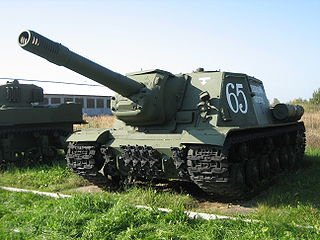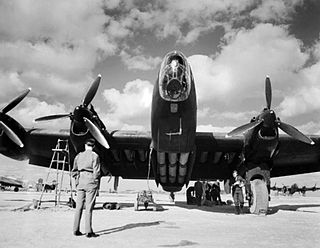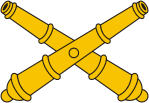Sabotage is a deliberate action aimed at weakening a polity, government, effort, or organization through subversion, obstruction, demoralization, destabilization, division, disruption, or destruction. One who engages in sabotage is a saboteur. Saboteurs typically try to conceal their identities because of the consequences of their actions and to avoid invoking legal and organizational requirements for addressing sabotage.

The ISU-152 is a Soviet self-propelled gun developed and used during World War II. It was unofficially nicknamed Zveroboy in response to several large German tanks and guns coming into service, including Tigers and Panthers. Since the ISU-152's gun was mounted in a casemate, aiming it was awkward, and had to be done by repositioning the entire vehicle using the tracks. Therefore, it was used as mobile artillery to support more mobile infantry and armor attacks. It continued service into the 1970s and was used in several campaigns and countries.

Operation Bagration was the codename for the 1944 Soviet Byelorussian strategic offensive operation, a military campaign fought between 22 June and 19 August 1944 in Soviet Byelorussia in the Eastern Front of World War II, just over two weeks after the start of Operation Overlord in the west. It was during this operation that Nazi Germany was forced to fight simultaneously on two major fronts for the first time since the war began. The Soviet Union destroyed 28 of 34 divisions of Army Group Centre and completely shattered the German front line. The overall engagement is the largest defeat in German military history, with around 450,000 German casualties, while 300,000 other German soldiers were cut off in the Courland Pocket.

Kovel is a city in Volyn Oblast, northwestern Ukraine. It serves as the administrative center of Kovel Raion within the oblast. Population: 67,575.
Soviet partisans were members of resistance movements that fought a guerrilla war against Axis forces during World War II in the Soviet Union, the previously Soviet-occupied territories of interwar Poland in 1941–45 and eastern Finland. The activity emerged after Nazi Germany's Operation Barbarossa was launched from mid-1941 on. It was coordinated and controlled by the Soviet government and modeled on that of the Red Army.

The French Forces of the Interior were French resistance fighters in the later stages of World War II. Charles de Gaulle used it as a formal name for the resistance fighters. The change in designation of these groups to FFI occurred as France's status changed from that of an occupied nation to one of a nation being liberated by the Allied armies. As regions of France were liberated, the FFI were more formally organized into light infantry units and served as a valuable manpower addition to regular Free French forces. In this role, the FFI units manned less active areas of the front lines, allowing regular French army units to practice economy of force measures and mass their troops in decisive areas of the front. Finally, from October 1944 and with the greater part of France liberated, the FFI units were amalgamated into the French regular forces continuing the fight on the Western Front, thus ending the era of the French irregulars in World War II.

No. 148 Squadron was a squadron of the Royal Air Force disbanded and re-established several times since the First World War, until its dissolution on 1 May 1965. During the Second World War, the squadron operated as a Special Duties squadron performing partisan supply missions and working closely with the Special Operations Executive for agent drop and pick-up operations.

Oleksiy Fedorovych Fedorov, was one of the leaders of Soviet partisan movement during World War II. He was twice awarded the title Hero of the Soviet Union, making him one of the only two partisan leaders to receive the title twice.

Smila is a city located on Dnieper Upland near the Tyasmyn River, in Cherkasy Raion, Cherkasy Oblast of Ukraine. The Tiasmyn River, a tributary of the Dnieper River, flows through the city. In January 2022, the estimated population was 65,675 a 1.2% decrease from 2021.

The 492nd Special Operations Wing is a United States Air Forces unit stationed at Hurlburt Field, Florida. It was activated in May 2017 to replace the Air Force Special Operations Air Warfare Center.
Vladimir Nikolaevich Druzhinin was a Soviet state and party leader, a Hero of the Soviet Union during World War II and an active participant in the partisan movement in Ukraine through the Chernihiv Commissioner-Volyn. In February 1940, Druzhinin was elected second secretary of the Communist Party's Ternopil oblast committee, a post in which he served until July 1941. By a Decree of the Presidium of the Supreme Soviet of the USSR dated 4 January 1944, for organizing a guerrilla movement behind enemy lines against the Nazis, Druzhinin was named a Hero of the Soviet Union with the Order of Lenin and Gold Star number 2884.
Operation Ratweek was a series of coordinated attacks on the Axis forces' communication lines in the Balkans during World War II. Launched on 1 September 1944. the attack was led by the combined operations units of the Yugoslav Partisans, Land Forces Adriatic, the heavy bombers of the U.S. 15th Air Force and the light and medium bombers of the Balkan Air Force.
The 203rd Rifle Division was an infantry division of the Soviet Union's Red Army.

The Central Headquarters of the Partisan Movement was the central organ of military control of the Soviet partisans, resistance movements who fought against German occupation in World War II. Located at the Headquarters of the Supreme High Command of the USSR Armed Forces, the GKO created it in May 1942 in order to unite the leadership of the Soviet partisan forces behind enemy lines. The State Defense Committee disbanded it in January 1944 due to most partisan detachments operating in Ukraine and Belarus, which already had their own headquarters for the partisan movement.

Railway sabotage was one of the main tactics used by the resistance to German occupation during World War II. Partisans and rail workers used sabotage to harass and confuse the invaders, misdirect, destroy, and lose their troops and supplies, and to damage railroad infrastructure, denying the occupiers its use.

The Rail War was the name for a World War II action of Soviet partisans and the German Kampfgruppen des NKFD as their auxiliary force in the Soviet Union, especially in German-occupied Byelorussia and Ukraine. The operations were carried out with the intention of disrupting German logistics via the destruction of rail lines, thus preventing the travel of equipment and manpower to the front.

642nd Cannon Artillery Regiment of the Reserve of the Main Command was a military formation of the Armed Forces of the Soviet Union that took part in the Great Patriotic War.
Rail sabotage is one of the Belarusian forms of grassroots action opposing the Russian invasion of Ukraine.
During the Russian invasion of Ukraine, Russia occupied vast portions of the territory of Ukraine, having already occupied parts of the Donetsk and Luhansk oblasts as well as the entire Autonomous Republic of Crimea since the beginning of the Russia-Ukraine war in 2014. Partisan groups began to be organized in mid-2022. These groups have been involved in intelligence-gathering, sabotage, and assassinations. Much of their activity has taken place in the Kherson and Zaporizhzhia regions.
Aleksandr Ivanovich Pomazunov was a Soviet military aviation navigator. He participated in the Battles of Khalkhin Gol, and the Second World War. He was awarded the title of Hero of the Soviet Union in 1945, and had the rank of Guard Major.











